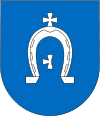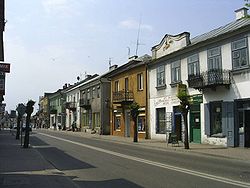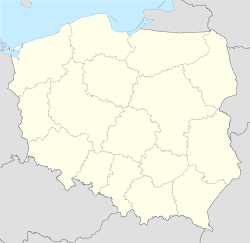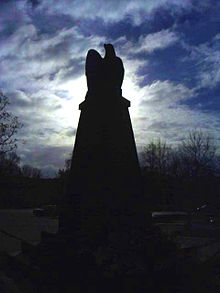- Międzyrzec Podlaski
-
Międzyrzec Podlaski Lubelska Street 
Flag
Coat of armsCoordinates: 51°59′0″N 22°47′0″E / 51.983333°N 22.783333°E Country  Poland
PolandVoivodeship Lublin County Biała Podlaska Gmina Międzyrzec Podlaski (urban gmina) Established 12th century Town rights 15th century Government – Mayor Artur Jan Grzyb Area – Total 20.03 km2 (7.7 sq mi) Elevation 148 m (486 ft) Population (2006) – Total 17,162 – Density 856.8/km2 (2,219.1/sq mi) Time zone CET (UTC+1) – Summer (DST) CEST (UTC+2) Postal code 21-560 Area code(s) +48 83 Car plates LBI Website http://www.miedzyrzec.pl Międzyrzec Podlaski [mjɛnˈd͡zɨʐɛt͡s pɔdˈlaski] is a city in Biała Podlaska County, Lublin Voivodeship, Poland, with the population of 17,162 inhabitants as of 2006. The total area of the city is 20.03 km2. Międzyrzec is located near the Krzna river, not far from the border with Belarus.
Contents
History of Międzyrzec Podlaski
The first official mention of Międzyrzec Podlaski as a city dates back to 1434, or (alternatively) 1455 and 1477 according to different historical sources.[1] In 1795, during Partitions of Poland, the city was annexed by Austro-Hungarian Empire. From 1809 until 1815, it belonged to the Duchy of Warsaw, and after Napoleonic Wars to Congress Poland under the control of the Russian Tsar.[2] In 1867 the city became a stop on the Polish railway. Already since the 16th century Międzyrzec was home to a large Jewish community. At the end of the 1930s in the reborn Polish Republic approximately 12,000 inhabitants, or ¾ of its population, were Jewish.
World War II
In 1939, during the Nazi–Soviet Invasion of Poland, the city was overrun by Wehrmacht on September 13, 1939, and ceded to the Russians on September 25, in accordance with the Molotov–Ribbentrop Pact. Two weeks later, it was transferred back to Germany after the new Boundary Treaty.[3] In 1940 six separate slave-labor camps were set up by the Nazis for some 2,000 local Jews; along with Judenrat, and the Jewish police.[3]
The German army entered the Soviet occupation zone on June 22, 1941 under the codename Operation Barbarossa. More Jews from the surrounding area including expellees from Kraków were shipped in. On April 19, 1942 the Jews were ordered by the Gestapo to turn over 50 kilograms of gold within 3 days. Some 40 hostages were murdered on the streets.[3] On August 25–26, 1942, the first mass deportation of Jews from Międzyrzec took place with around 10,000 prisoners forcibly put on 52 cattle cars (shipment #566 according to the German inventory) and sent to Treblinka extermination camp. Two days later, the Międzyrzec Podlaski Ghetto was established under the management of Judenrat. Several more mass deportation actions followed. On the 17th of July 1943, the ghetto was officially liquidated, along with the local transit camp. Fewer than 1% of the Jewish population of the city survived the Nazi mass executions and deportations to death camps.
Economy
Of the approximately 4,900 employed citizens of the city, ca. 36% work in industrial fields, 19% in trade markets, and 11% in education. The unemployment rate in the city was 22% in October 2005.
The town lies at the intersection of two important national roads: DK2 (Poland's main east-west connector) and DK19. In the future Expressway S19 will run just west of the town. A 6.6 km (4.10 mi) section of it already constructed as the town's bypass road and opened in 2008 allows north-south traffic on DK19 road to avoid the town centre.
International relations
Międzyrzec Podlaski is referred to by various names in different languages including Yiddish: מעזריטש Mezri'tsh, Latin: Meserici, Belarusian: Міжрэчча, German: Meseritz, Latvian: Meņdzižeca Podlaska, Lithuanian: Palenkės Mendzyžecas, and Ukrainian: Межиріччя.
Not to be confused with Mezhirich or Mezhirichi.Twin towns — Sister cities
Międzyrzec Podlaski is twinned with:
Notable people
- Jan Brożek
- Dov Ber of Mezeritch
- Adam Kazimierz Czartoryski
- August Aleksander Czartoryski
- Konstanty Adam Czartoryski
- Yehoshua Leib Diskin
- Morris Michael Edelstein
- Judah David Eisenstein
- Stanisław Jan Jabłonowski
- Jacob ben Wolf Kranz
- Kazimierz Kierzkowski
- Ryszard Kornacki
- Sława Przybylska
- Franciszek Stefaniuk
- Stanisław Żmijan
External links
- ^ "Międzyrzec Podlaski – Historia miejscowości". Virtual Shtetl Museum of the History of Polish Jews. http://www.sztetl.org.pl/pl/article/miedzyrzec-podlaski/3,historia-miejscowosci/. Retrieved July 24, 2011.
- ^ "Ziemia międzyrzecka. Historia". Urząd Miasta Międzyrzec Podlaski. http://www.miedzyrzec.pl/um/index.php?id_podkat=4. Retrieved July 24, 2011.
- ^ a b c "Jewish heritage of Międzyrzec Podlaski". Association of Immigrants of Mezritch Depodalsia Area in Israel. http://www.mezritch.org.il/eng-text/eng-town.html. Retrieved July 26, 2011.
- Międzyrzec Podlaski Home Page (in Polish)
- Portal of young people of Międzyrzec Podlaski
- Międzyrzec Podlaski Amateur Photography Board (in Polish)
Coordinates: 51°59′N 22°47′E / 51.983°N 22.783°E
Biała Podlaska County Seat (not part of the county): Biała PodlaskaUrban gminas Międzyrzec Podlaski • Terespol
Rural gminas Gmina Biała Podlaska • Gmina Drelów • Gmina Janów Podlaski • Gmina Kodeń • Gmina Konstantynów • Gmina Leśna Podlaska • Gmina Łomazy • Gmina Międzyrzec Podlaski • Gmina Piszczac • Gmina Rokitno • Gmina Rossosz • Gmina Sławatycze • Gmina Sosnówka • Gmina Terespol • Gmina Tuczna • Gmina Wisznice • Gmina ZalesieVillages Bereza • Dołhołęka • Halasy • Jelnica • Kolonia Wolańska • Koszeliki • Kożuszki • Krzewica • Krzymoszyce • Łuby • Łukowisko • Łuniew • Manie • Misie • Pościsze • Przychody • Przyłuki • Puchacze • Rogoźnica • Rogoźnica-Kolonia • Rogoźniczka • Rudniki • Rzeczyca • Sawki • Sitno • Strzakły • Tłuściec • Tuliłów • Utrówka • Wólka Krzymowska • Wysokie • Żabce • Zaścianki • Zasiadki • Zawadki
Seat (not part of the gmina) Międzyrzec PodlaskiCategories:- Cities and towns in Lublin Voivodeship
- Biała Podlaska County
- Shtetls
Wikimedia Foundation. 2010.



